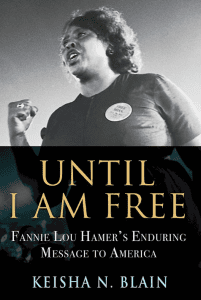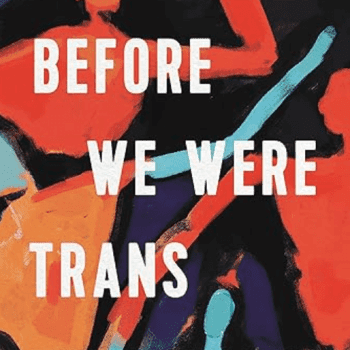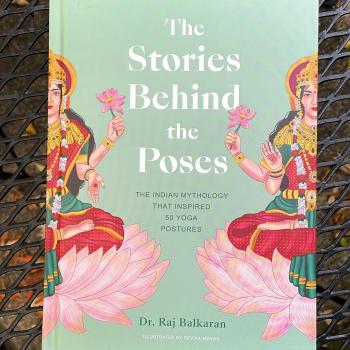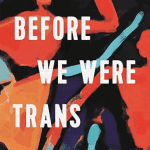I would like to invite us to spend some time reflecting on the life and legacy of Fannie Lou Hamer (1917 – 1977). Her story feels like a perfect bridge as we move from Black History Month into Women’s History Month.
 If this post leaves you curious to learn more, I was inspired to blog about her by two excellent and accessible biographies that were published recently. The first is from Beacon Press, Until I Am Free: Fannie Lou Hamer’s Enduring Message to America by Keisha Blain, a history professor at the University of Pittsburg. I recommend starting with Blain’s book, and I’ll also give a brief shout out to Beacon Press, which is owned by the Unitarian Universalist Association. They have a strong track record of publishing an incredible line of books year after year.
If this post leaves you curious to learn more, I was inspired to blog about her by two excellent and accessible biographies that were published recently. The first is from Beacon Press, Until I Am Free: Fannie Lou Hamer’s Enduring Message to America by Keisha Blain, a history professor at the University of Pittsburg. I recommend starting with Blain’s book, and I’ll also give a brief shout out to Beacon Press, which is owned by the Unitarian Universalist Association. They have a strong track record of publishing an incredible line of books year after year.
The second Hamer biography is also good; it’s from Oxford University Press. Walk with Me: A Biography of Fannie Lou Hamer is by Kate Larson, a women’s studies scholar at Brandeis University. There has been a renewed interest in Hamer lately, partly because her work for voting rights feels newly relevant in the wake of dismaying ongoing attempts to undermine the integrity of our democracy.
One of the reasons Hamer remains so inspiring is that she was born to a family with very few resources. She had the opportunity to go to school for only about four months each year, and stopped going altogether at age 12 (Blain 4). But she more than made up for that with her passion for social justice (x).
Hamer was born in Mississippi in 1917, the youngest of twenty children. Her grandparents had been enslaved. She, her parents, and her siblings were sharecroppers, meaning that they were allowed to farm land owned by someone else in return for a share of their crops. Sharecropping, at least as it was practiced at that time in the south, was typically an exploitative system patterned after enslavement.
In Hamer’s words, “Life was very hard. We never hardly had enough to eat. We didn’t have enough to wear. We had to work real hard. I started working when I was six years old.” Despite how hard her family worked, it was all but impossible to make ends meet. She said, “So many times for dinner we would have greens with no seasonin’…and flour gravy. My mother would mix flour with a little grease and try to make gravy out of it” (3).
Sharecropping was set up to be the only option for many Black families. Structurally biased in favor of enriching white landowners and keeping Black families in debt, sharecropping was quite deliberately designed to keep White Supremacy entrenched (x, 4). As the saying goes, “The system isn’t broken, it’s built this way.”
Sharecropping dominated Fannie Lou Hamer’s life for her first forty-five years, from her birth in 1917 to one fateful evening in 1962, when she found her calling. But before I tell you about that night, I want to say something about the first four-and-a-half decades of Hamer’s life. There is a lot to say, but I’ll limit myself to two representative stories that helped prepare her for the moment when her call to activism came.
The first story occurred when Hamer was quite young. One day, she asked her mother why she wasn’t white, saying, “White people have clothes, they have food to eat, and we work all the time, and we don’t have anything (Larson 5). She never forgot how clear her mother was in her response, by teaching her that, “Black is beautiful and not a shade less than beautiful…. My mother told me that she wanted me to respect myself as a black child, and as I got older she told me to respect myself as a black woman.” And even though the family had very little money, her mother saved up enough to buy her a black doll. Hamer said, “I was the only Black child [I knew] with a Black doll” (Blain 7).
The second story happened when Hamer was a young woman. She saw a white supervisor on the plantation they worked raise his arm to hit one of her brothers. Their mother grabbed the supervisor’s arm, and made it clear that no one but her had permission to discipline her children. This act could have cost her her life, but her mother was also known to carry a 9-millimeter pistol while she worked the sharecropping fields (9).
Both of these stories reflect what the UU First Principle calls “The inherent worth and dignity of every person.” These and similar experiences laid the groundwork for Hamer to be ready to respond to an unexpected calling that profoundly shaped the final decade-and-a-half of her life, right up until her death from cancer in 1977 at the too-young age of 59.
Let’s fast-forward now to that fateful day, Monday, August 27, 1962, when a forty-four-year-old Fannie Lou Hamer heard a call to activism while attending her first meeting of the Student Nonviolent Coordinating Committee, often abbreviated as SNCC. At that meeting, Hamer learned for the first time that the United States Constitution prohibits the federal government and every state from denying a citizen’s right to vote “on account of race, color, or previous condition of servitude” (Fifteenth Amendment). She said, “They were talking about [how] we could vote out people that we didn’t want in office. That sounded interesting enough to me that I wanted to try it” (1).
In theory, Black citizens of the United States were guaranteed the right to vote in 1870 by that same Fifteenth Amendment passed in the wake of the Civil War. In practice, many unjust hurdles were set up to prevent Black Americans from voting. To use Hamer’s home state as an example, in the 1960s, almost a century after the Fifteenth Amendment became the law of the land, “Only 5 percent of Mississippi’s 450,000 Black residents were registered to vote.”
This race gap in registered voters is why the Voting Rights Act of 1965 was so important, and why it is so tragic that the U.S. Supreme Court gutted it in 2013. As Eric Holder has detailed in his important book, Our Unfinished March: The Violent Past and Imperiled Future of the Vote: A History, a Crisis, a Plan, that ruling paved the way for many new racist voting restrictions afflicting our democracy today (11-12). I’m getting ahead of the story, but I want to keep reminding us of why Hamer’s example remains such an important touchstone for our own work for voting rights.
One of Hamer’s mottos was, “Hands that pick cotton now pick public officials” (Blain 15). She also used to say that, “If we had been treated right all these years, they wouldn’t be afraid for us to get the ballot” (14).
Let me hasten to be clear that Hamer was not threatening revenge. Instead, her motivation was deeply connected to my post a few weeks ago on what Dr. King called interdependence, what Thich Nhat Hanh called interbeing, and what the UU Seventh Principle calls “the interdependent web of all existence.” Hamer has urged us to see that racism is a sickness in our society that has its most direct impact on African Americans, but is also toxic for everyone else because of the ways it creates a broken society with terrible ramifications for all (ix).
Hamer’s goal was collective liberation so that we all get free. In her words, “The changes we have to have in this country are going to be for the liberation of all people— because nobody’s free until everybody’s free” (20). She would add, “I’m not fighting for a black Mississippi. I’m fighting for a people’s Mississippi. I’m not fighting to seat an all-black government in the state of Mississippi, but I want you to know something, white people, it certainly ain’t going to be an all-white one either” (52).
Having briefly explored the larger context, let’s back up to the major turning point in Hamer’s life — the day she attended her first SNCC meeting, Monday, August 27, 1962. A mere five days later on Friday, August 31, she and other courageous allies boarded a bus to register to vote. At the courthouse, her group was met by what she described as “more policemen with guns than I’d ever seen in my life at one time.”
Inside the courthouse, they were given discriminatory literacy tests designed to keep Black citizens disenfranchised. Hamer said that the registrar pointed to the sixteenth section of the constitution of Mississippi and asked her to explain the meaning of de facto laws. She later said, “I know about as much about a de facto law as a horse knows about New Year’s. Quite naturally, I flunked the test” (28-29).
On the way home, their group was pulled over by one of the policemen from the courthouse, and they were fined the equivalent of $850 today for driving a bus whose color was “too yellow,” a flagrantly trumped-up charge 29).
The more consequential impact came when she returned home and was kicked off the plantation where she and her husband were sharecroppers. I want you to hear Hamer tell that story, but first let me set the stage.
Hamer may have had little formal education, but she had charisma, and her leadership potential was quickly recognized. In August 1964 — a mere two years after she attended her first SNCC meeting — she found herself speaking at the 1964 Democratic National Convention. She was representing the Freedom Democratic Party, which was lobbying for the first Black Mississippi delegates to the DNC. At that time Mississippi’s Democratic Party only allowed white delegates even though African Americans made up 40% of that state’s population (Larson 1).
In the wake of President Kennedy’s assassination the previous November, Lyndon Johnson was vying for the nomination. Johnson was so scared that Hamer’s speech would lose him the support of southern segregationists that he called a presidential press conference during Hamer’s testimony and delivered what was widely described as an “unmemorable three-minute statement.”
Johnson did succeed in blocking Hamer from being viewed live. But here’s the thing: television networks have more than one camera crew. And excerpts of her speech, including the standing ovation she received, were featured prominently on news programs that evening. Despite Lyndon Johnson’s best efforts to prevent it, “The whole nation watched as a dirt-poor Mississippi sharecropper with a sixth-grade education shamed them into acknowledging how deeply and profoundly broken American democracy had become” (2).
I want to invite you to hear at least the final minute or so of that speech, but the full eight-minutes are well worth watching and are widely available online. Hamer begins her speech by telling the story of what happened when she returned home from trying to register to vote, an act which should have been her Constitutional right since 1870. (Her speech is available at https://www.youtube.com/watch?v=agBzy3ATja0&t=1s.)
The next year, in 1965, when voting rights legislation was making its way through Congress, she wanted to be present in person. But she was stopped at the door by Adam Clayton Powell, the first African American to be elected to Congress from New York, as well as the first from any state in the Northeast. He told her and the two Black women accompanying her, “I don’t think you should go. You go on the floor of Congress, you will become the first [Black] woman to ever walk on the floor of Congress.” Hamer replied: “Well, get your pen out and start writing ‘cause we are going” (Larson 208). That day, Fannie Lou Hamer — and two other civil rights activists with her, Victoria Jackson Gray and Annie Devine — became “the first Black women to be seated on the floor of the United States House of Representatives” (206).
There is so much more to say about the life and legacy of Fannie Lou Hamer, but for now, let me move toward my conclusion with two additional encouragements Hamer might give us if she were alive today.
The first encouragement is, if you feel called to help make this world a better place, don’t let your anything about your background hold you back. She showed us that anyone with enough passion and commitment can make a difference. In Hamer’s words: “Don’t worry about the qualifications, because just like they learned it, you can too…. Whether you have a Ph.D…or no D., we’re in this bag together. And whether you’re from Morehouse or Nohouse, we’re still in this bag together” (Blain 48).
The second encouragement is to keep on moving forward because justice has already been denied far too long. In her words, “For three hundred years, we’ve given them time. I have been tired so long, now I am sick and tired of being sick and tired” (Blain 100).
Today, as we work for voting rights and to expand access to the democratic process — as Fannie Lou Hamer and so many other did before us— we know that the work is hard. But our call — as she demonstrated — is to keep on moving forward until we make Election Day an annual national holiday, until we abolish the filibuster, until we win statehood for Washington, D.C. and Puerto Rico, and so much more.
So much is needed to build the world we dream of, and yes, it will be hard to achieve. But Fannie Lou Hamer reminds us that we can do hard things. And no matter who you are or where you come from, you are needed in the struggle for justice to help turn our dreams into deeds — and to build a world with peace, liberty, and justice, not merely for some, but for all. Your voice matters, each person’s dignity matters, and we are stronger together. I am grateful to be on that journey with all of you.
As we continue to discern how we are called to act in the days to come, both individually and collectively within our spheres of influence, I will conclude by inviting you to listen to a power song about Fannie Lou Hamer’s life by Sweet Honey in the Rock, available at https://www.youtube.com/watch?v=WIJA-PZ150A.
The Rev. Dr. Carl Gregg is a meditation teacher, spiritual director, and the minister of the Unitarian Universalist Congregation of Frederick, Maryland. Follow him on Facebook (facebook.com/carlgregg) and Twitter (@carlgregg).
Learn more about Unitarian Universalism: http://www.uua.org/beliefs/principles














